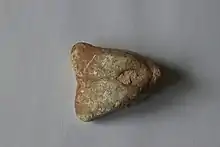Pygope
Pygope is an extinct genus of brachiopods belonging to the family Pygopidae. These brachiopods lived in open sea from the Jurassic Period, Kimmeridgian age (152.1–157.3 mya) up to Cretaceous Period, Barremian age (125.0–~129.4 mya). Some of the species are characterised by a smaller or larger perforation through the entire shell in older specimens, while others just have a depression somewhere on the midline. Younger specimens of the perforated species develop a heart-shape and subsequently both extensions merge, thus encircling a central passage which is in fact entirely outside the shell.[1]
| Pygope | |
|---|---|
 | |
| Fossil specimen of Pygope sp from Spain, Guadalajara | |
| Scientific classification | |
| Kingdom: | |
| Phylum: | |
| Class: | |
| Order: | |
| Suborder: | Terebratulidina |
| Family: | |
| Genus: | Pygope Link, 1830 |
| species | |
| |
| Synonyms | |
|
Antinomia | |
Distribution
- P. catulloi occurs in Upper Jurassic (Tithonian) to Lower Cretaceous (Valanginian) of Austria, Bulgaria, Hungary, Italy, Poland, Romania and Switzerland.[2]
- P. diphya has been found in the Lower Cretaceous of Poland (Early Berriasian, Rogoza Klippes, Rogoznik, 49.5° N, 19.9° E,[3] Euxinus Zone-Occitanica Zone, Sobotka and Korowa Member, Dursztyn Formation, Cisowa Skala, Bursukowa Skala, Lysa Skala, and Czorsztyn-Sobotka, 49.0° N, 20.0° E),[4] Slovakia (Berriasian, Rogoznik Member, Durstyn Formation), Kyjov, Puste Pole, 49.0° N, 20.0° E).[5]
- P. janitor is present in the Upper Jurassic of Bulgaria (Kimmeridgian, Lacunosella sparcicosta zone, Nechinska Bara, Gorno Belotintsi, 43.5° N, 22.9° E),[6] Hungary (Lower Tithonian, Szel-hegy, Gerecse Mts, 47.0° N, 18.0° E),[7] Poland (Early through to Late Titonian, Rogoza Klippes, Rogoznik, 49.5° N, 19.9° E),[3] the Lower Cretaceous of Greenland (North Mols Bjerge, Traill Island, and Brorson Halvo, Wollaston Forland, both Lower Valanginian, Albrechts Bugt Member, Palnatokes Bjerg Formation east Greenland)[8] and Poland (Berriasian, Euxinus Zone-Occitanica Zone, Sobotka and Korowa Member, Dursztyn Formation, Cisowa Skala, Lysa Skala, Bursukowa Skala, Czorsztyn-Sobotka and 49.0° N, 20.0° E).[4]
References
- Jarre, Pierre (1962). "Révision du Genre Pygope" (PDF). Géologie Alpine. 38: 23–120.
- Lukeneder, Alexander (2002). "Shell accumulation of the brachiopod Pygope catulloi PICTET, 1867 (Lower Valanginian; Northern Calcareous Alps, Upper Austria): Palaeoecological implications" (PDF). Annalen des Naturhistorischen Museums in Wien. 103A: 143–159.
- Barczyk, W. (1991). "Succession of the Tithonian to Berriasian brachiopod faunas at Rogoznik, Pieniny Klippen Belt". Acta Geologica Polonica. 41 (1–2): 101–107. cited in Wolfgang Kiesling. "Rogoza Klippes at Rogoznik". Fossilworks.
- Krobicki, M. (1994). "Stratigraphic significance and palaeoecology of the Tithonian-Berriassian brachiopods in the Pieniny Klippen Belt, Carpathians, Poland". Studia Geologica Polonica. 106: 89–156. cited in Adam Tomasovych. "Cisowa Skala". Fossilworks.
- Tomasovych, A. (2006). Differential effects of environmental factors on ecology of brachiopods and bivalves during the Late Triassic and Jurassic. p. 430. cited in Adam Tomasovych. "Kyjov - Puste Pole - bed 34.21". Fossilworks.
- Tchoumatchenco, P. (1996). "Zonation and paleoecological distribution of Bulgarian Jurassic brachiopods". In P. Copper; J. Jin (eds.). Brachiopods. pp. 269–274. cited in Uta Merkel. "Nechinska Bara, Gorno Belotintsi". Fossilworks.
- Fozy, I.; Kazmer, M.; Szente, I. (1994). "A unique Lower Tithonian fauna in the Gerecse Mts, Hungary". Palaeopelagos Special Publication. 1: 155–165. cited in Danica Hempfling. "Szel-hegy". fossilworks.
- Alsen, P.; Rawson, P.F. (2005). "The Early Valanginian (Early Cretaceous) ammonite Delphinites (Pseudogarnieria) from North-East Greenland". Bulletin of the Geological Society of Denmark. 52 (2): 201–212. cited in Ute Merkel. "N Mols Bjerge, Traill Island, Palnatokes Bjerg Formation, E Greenland". Fossilworks.
This article is issued from Wikipedia. The text is licensed under Creative Commons - Attribution - Sharealike. Additional terms may apply for the media files.